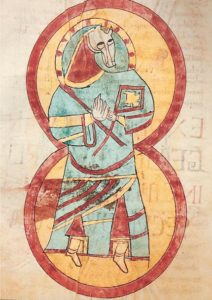The Codex Gigas
The Codex Gigas or the Devil’s Bible is a medieval manuscript at the National Library in Stockholm that is famous for two features. First, it is reputed to be the biggest surviving European manuscript. Secondly, it contains a large, full page portrait of the Devil.
This site contains a digitised version of every page of the manuscript as well as commentaries on its history, texts, script, initials and decoration.
The manuscript was made in Bohemia (now part of the modern Czech Republic) between about 1200 and 1230. It is remarkable that virtually all of the manuscript, script, initials and decoration, appears to have been the work of one person who probably worked in a Benedictine monastery. The Codex Gigas contains four long texts as well as a complete Bible. The manuscript begins with the Old Testament, and it is followed by two historical works by Flavius Josephus who lived in the first century AD. These are The Antiquities and The Jewish War. ..
Manuscrit numérisé (digitised version) [En ligne]
Stockolm, National Library [En ligne]
Indiqué: blog The medieval scriptorium [En ligne]
National Digital Library Polona
National Digital Library Polona presents the most interesting manuscripts from the collection of the national Library :
 Copyright ® 2006 Biblioteka Narodowa
Copyright ® 2006 Biblioteka Narodowa
Psalterium. Latin, French. 13th century. Parchment. Ilum. 15,5 x 10,5 cm. K. 170 + VI. 19th century velvet binding. Rps BN I 8003 Psałterz wilanowski, called also Psałterz Potockich is a 13th century hand-written psalter. Thanks to its excellent painting technique, perfect drawings and conscientious execution of full-page miniatures, is regarded as one of the best works of Paris studios in the early Gothic period. It is ornamented with 4 fullpage miniatures, six figurative initials (which, in keeping with the principle adopted for this kind of psalter, mark the beginning of psalms), small calligraphic initials and colourful interlines. The Psalter, probably purchased in Paris at the beginning of the 19th century for Stanisław Kostka Potocki’s Wilanów Library, was transferred in 1932 to the National Library together with the Wilanów collections. In 1939 it was evacuated to Canada, whence it returned twenty years later.
List of manuscripts [Link]
Espagne: Virtual Library of Bibliographical Heritage
The Virtual Library of Bibliographical Heritage is a cooperative project of the Ministry of Culture and the Autonomous Regions, which aims to distribute printed books and manuscripts from Spain’s Historical Heritage by digital facsimile.
Biblioteca Virtual do Patrimonio Bibliográfico est un projet commun du Ministère de la Culture et des Régions autonomes pour présenter des impressions anciennes et des manuscrits du patrimoine espagnol sous forme numérisée.
Liste des auteurs
Liste des lieux d’impressions
Liste des imprimeurs
Lien [En ligne]
Information donnée par Klaus Graf in Archivalia
St Laurentius digital manuscript library

La Bibliothèque universitaire de Lund (Suède) met en ligne plusieurs dizaines de manuscrits numérisés dont plusieurs proviennent de France, avec description précise et bibliographie. A remarquer le ms 38, Bréviaire à l’usage de Saint-Julien de Tours (XVe s., 138 f., 175 x 120 mm), portant ex-libris au f. 1r : Breviarium ad usum monasterii S. Juliani Turonensis Congr. Sti Mauri.
\ »Other parts of the collection have come to the library through donations, acquisitions and testaments. Here are books by Classical authors like Cicero and Virgil, by post-classical writers like Boethius and by medieval theologians like Thomas Aquinas and Bonaventure. Here are the divine revelations of the Swedish 14th century saint Bridget, Danish and Swedish law texts as well as a Faroese manuscript with the so called Seydhabrevidh, a famous letter on sheep husbandry. We also find a copy of the Legenda Aurea, a collection of saints’ lives, of accounts of events in the lives of Christ and of the Virgin Mary and of information about holy days, by Jacobus de Voragine, very popular during the Middle Ages and a few copies of the medieval bestseller, the Book of Hours. The famous so called Lundse liederen, a fragment of a Dutch \ »Minnesänger\ » of the 13th century is also part of the collection. Deposited at the University Library by the Institute of Astronomy in Lund are several astronomical treatises, about the movements of the planets with descriptions of instruments with movable, threedimensional plans and diagrams. A few manuscripts are in other languages than Latin: Greek, Russian, Dutch, German, French apart from the Nordic already mentioned…
Contact :
UB Helgonabacken
Handskriftssektionen
Box 3
221 00 LUND
fax: 046-222 36 90
e-mail: handskrift@lub.lu.se
Source : site [En ligne]
PAGES ANNEXES
Auteur du blog : Jean-Luc DEUFFIC




